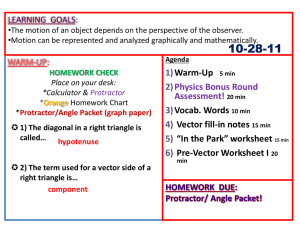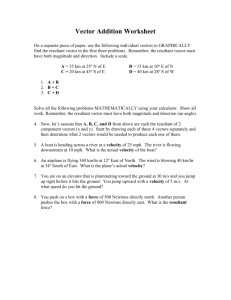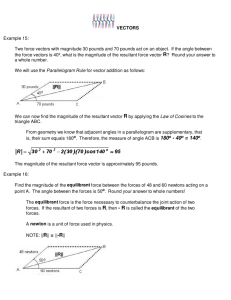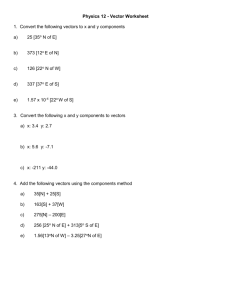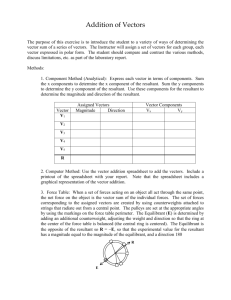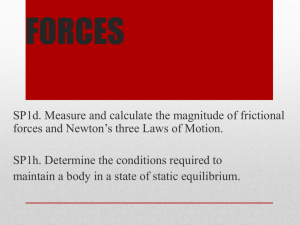COMBINING FORCES Problem
advertisement
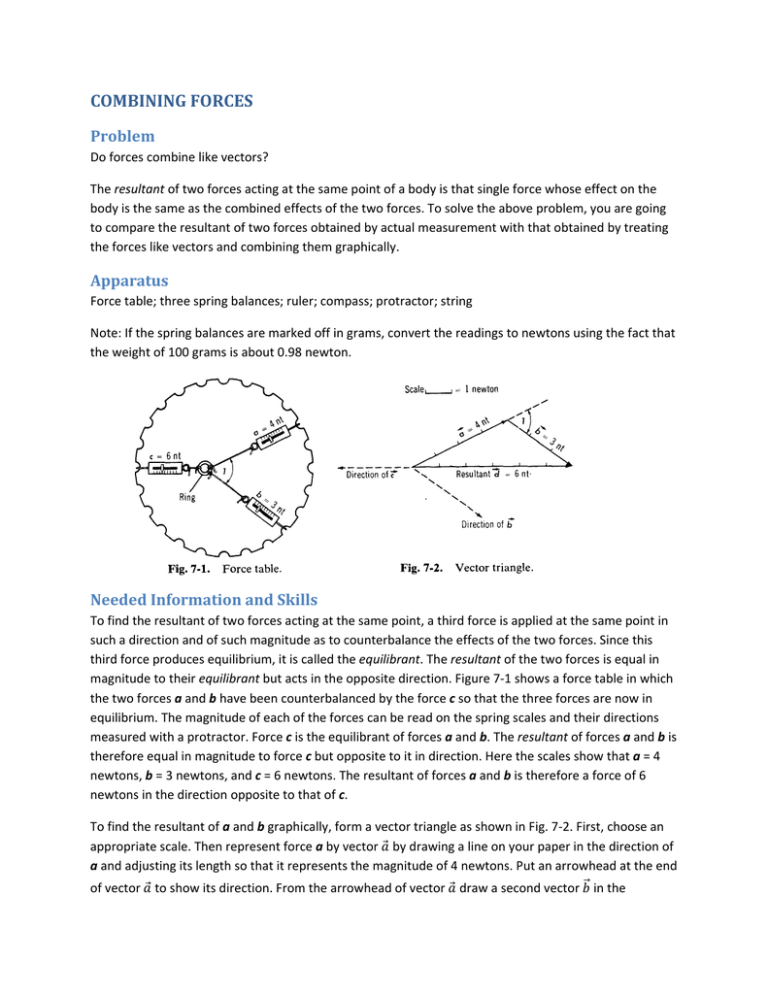
COMBINING FORCES Problem Do forces combine like vectors? The resultant of two forces acting at the same point of a body is that single force whose effect on the body is the same as the combined effects of the two forces. To solve the above problem, you are going to compare the resultant of two forces obtained by actual measurement with that obtained by treating the forces like vectors and combining them graphically. Apparatus Force table; three spring balances; ruler; compass; protractor; string Note: If the spring balances are marked off in grams, convert the readings to newtons using the fact that the weight of 100 grams is about 0.98 newton. Needed Information and Skills To find the resultant of two forces acting at the same point, a third force is applied at the same point in such a direction and of such magnitude as to counterbalance the effects of the two forces. Since this third force produces equilibrium, it is called the equilibrant. The resultant of the two forces is equal in magnitude to their equilibrant but acts in the opposite direction. Figure 7‐1 shows a force table in which the two forces a and b have been counterbalanced by the force c so that the three forces are now in equilibrium. The magnitude of each of the forces can be read on the spring scales and their directions measured with a protractor. Force c is the equilibrant of forces a and b. The resultant of forces a and b is therefore equal in magnitude to force c but opposite to it in direction. Here the scales show that a = 4 newtons, b = 3 newtons, and c = 6 newtons. The resultant of forces a and b is therefore a force of 6 newtons in the direction opposite to that of c. To find the resultant of a and b graphically, form a vector triangle as shown in Fig. 7‐2. First, choose an appropriate scale. Then represent force a by vector by drawing a line on your paper in the direction of a and adjusting its length so that it represents the magnitude of 4 newtons. Put an arrowhead at the end of vector to show its direction. From the arrowhead of vector draw a second vector in the direction of b. The length of is adjusted so that it represents 3 newtons and an arrow is put at the end of it to show its direction. The vector triangle is now completed by drawing a third vector from the tail of to the head of . An arrowhead is put at the end of pointing towards the head of . Vector is the resultant of and You can now measure the length of and determine its magnitude from the scale. Gathering the Data On the force table connect each of the three spring balances to the circular ring with the string. Tie the other ends of the balances to the edge of the force table so that no two balances have the same reading. For better results, adjust the balances so that they read 10 or more newtons. Also adjust the strings so that each balance pulls in a line through the center of the ring. Identify each of the spring balances as a, b, and c and record the reading of each spring balance in Table 7‐1 as Trial 1. Trial Force a Force b Force c Angle l 1 2 3 4 Table 7‐1 Place a large sheet of paper beneath the ring. Mark the center of the ring with a pencil and use a ruler to draw a line in the direction of each of the forces a, b, and c. Extend these lines until they meet in the center. With a protractor measure angle I and record its value in Table 7‐1. Consider forces a and b to be the two forces acting at a point. Force c is then their equilibrant. Their resultant is equal in magnitude to force c but opposite to it in direction. Starting at the common point on your paper at which forces a, b, and c act, make a vector triangle as described above to find the resultant of vectors and . Measure the length of vector determine its magnitude and record it in Table 7‐2 as Trial 1. Measure the angle between vector and the direction of force c and record it in Table 7‐2. Measured Magnitude of the Equilibrant c (N) Predicted Magnitude of the Resultant Vector (N) Angle between and Force (°) Table 7‐2 Trial 1 Trial 2 Trial 3 Trial 4 Solving the Problem If forces a and b combine like vectors, what should be the relationship between the observed magnitude and direction of the equilibrant and the predicted magnitude and direction of the resultant obtained by vector addition? Repeat the experiment with different forces and different angles between them as many times as the period will allow (recording your data as Trial 2, Trial 3, etc.). Do your results indicate that forces combine like vectors? Questions and Supplementary Activities 1. What are some sources of error in determining a resultant by adding vectors graphically? 2. Under what circumstances will forces a, b, and c be equal in magnitude? 3. Arrange the setup shown in Fig. 7‐3. Start with the rubber band about 1 inch from the right end of the ruler. Now move the rubber band to the left 1 inch at a time and note any changes in the length of the rubber band. Explain what you see.


